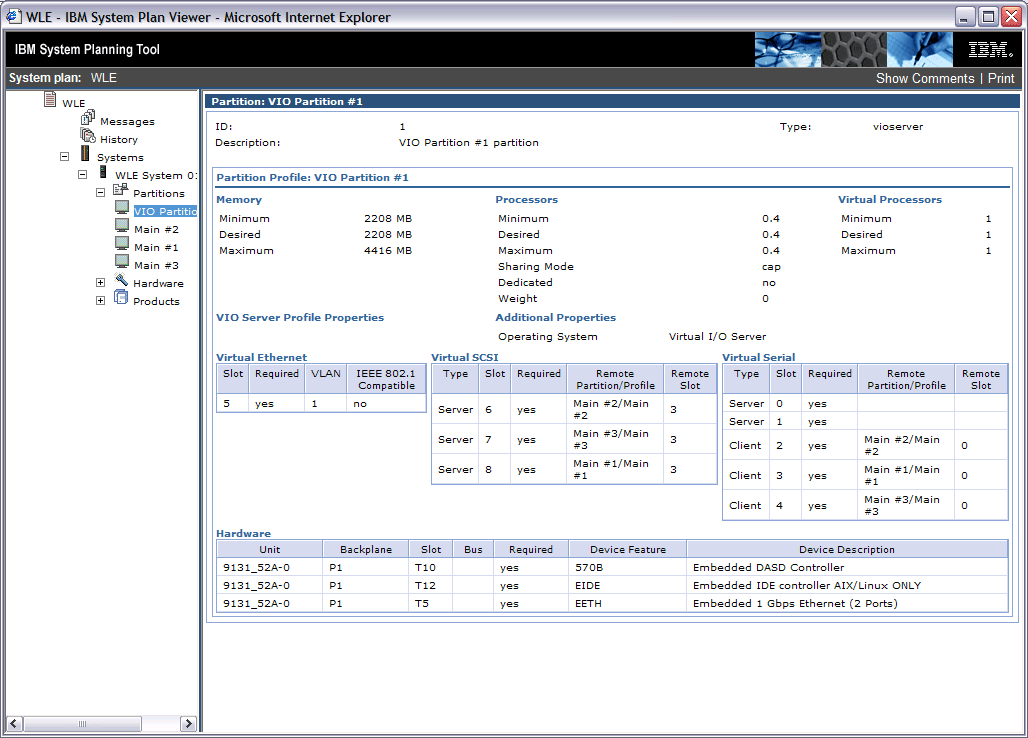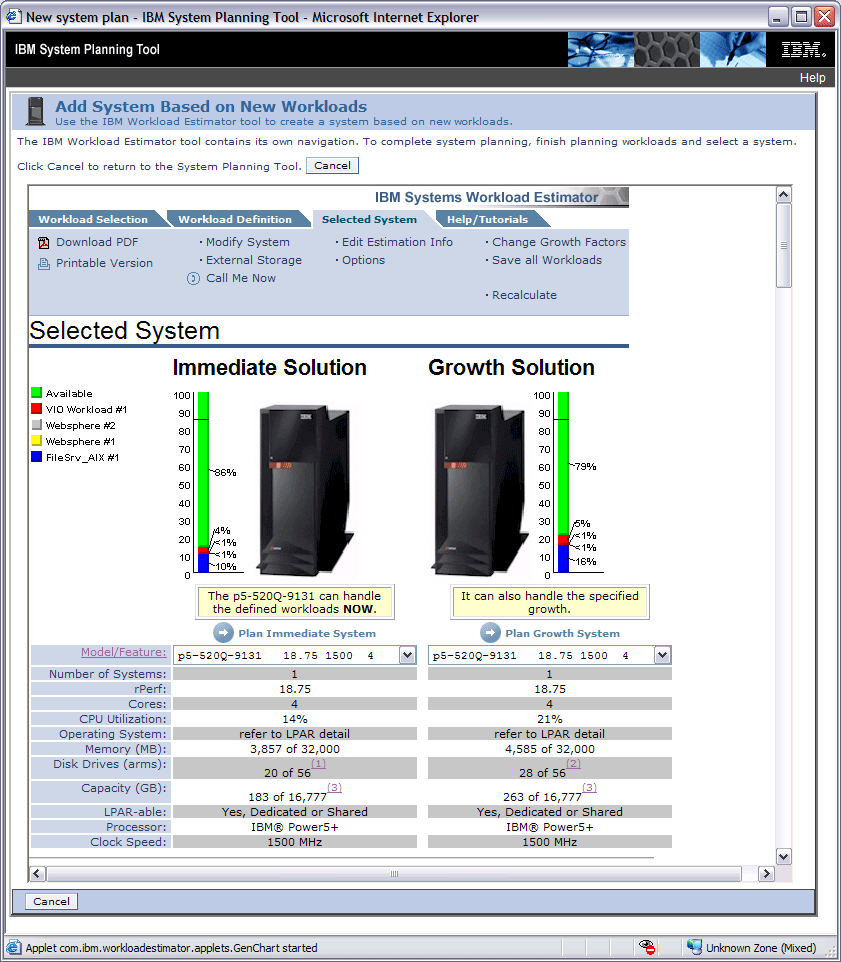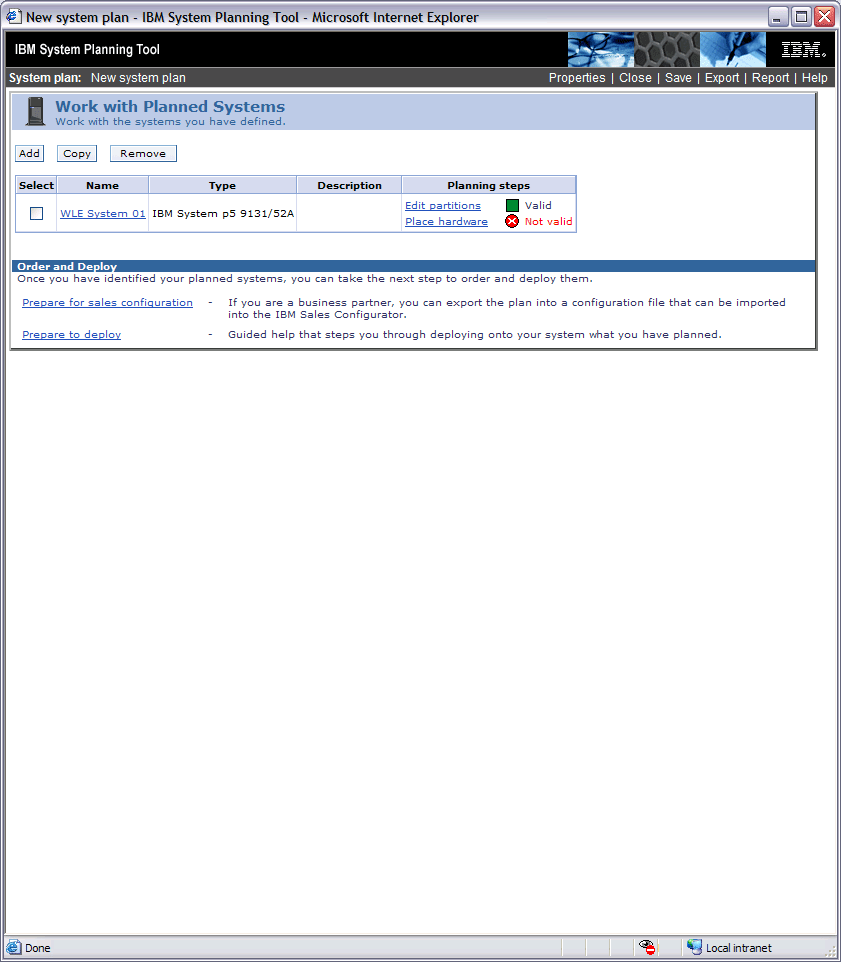Planning for a new IBM System i or p? Will your new system be partitioned? Want to plan your new system based on performance or workload data? The System Planning Tool (SPT) is made just for you, especially if you're currently using the LPAR Validation Tool (LVT). The SPT is the next generation of the LVT. It's a lot like LVT, but better.
The SPT is a great way to select, plan, validate, prepare to order, and document your new system. And, once your new system arrives, SPT makes it easy to set it up. You can also generate reports that outline the configuration and settings of your system. Are you a dedicated LVT user? Not to worry; plans created by LVT can be opened in SPT. So if you're already using LVT, you can easily migrate to SPT.
The SPT is a browser-based application designed to run on your PC. It's available as a free download from IBM. Like LVT, the SPT can be used to plan and partition a single system or a group of systems in a single plan. The SPT can create plans for the following systems:
- IBM System i5
- IBM eServer p5
- IBM eServer i5
- IBM Open Power
- IBM iSeries 8xx and 270 models
Roll Up Your Sleeves
The System Planning Tool is intended primarily for use by Business Partners and requires an extensive knowledge of IBM Systems hardware products. You'll also need a good working knowledge of logical partition design requirements, operating systems, limitations, and recommendations. However, IBM provides a nice set of sample systems within SPT. These samples are a great way to browse through valid system plans to learn how things work or to start a plan based on a pre-planned system.
If you are not a Business Partner, you can still use the SPT to collaborate with your Business Partner to plan a new system or plan changes to your existing systems. System plan files can be emailed back and forth, allowing you to work together to plan a solution that's right for you.
Once you have a complete and valid system plan, you can do some cool things with it. As with the LVT, as long as the hardware configuration and placement are correct, you can export a .cfr file that can be used in eConfig to generate an order for the system. However, at this time you cannot open a .cfr file from eConfig in the SPT. And beware: Withdrawn features and products and MES and Upgrade configurations are not supported by this path and should not be included in your configuration.
You can also import system plan files created by SPT into the Hardware Management Console (HMC) to set up your new system with the partition and hardware configuration specified in your plan.
Improvements over the LPAR Validation Tool (LVT)
Change is hard. So we've added some tempting features in the SPT to help ease the transition.
Generating Interactive and Printable Reports
From SPT, you can generate an interactive report that contains all the information about the systems you've specified, as shown in Figure 1. 
Figure 1: A system report contains all the information about the systems you've specified. (Click images to enlarge.)
The format of the report allows you to browse through any remaining validation messages, systems in the plan, and even individual partitions and the resources assigned to them. You can even dive into detailed information about the individual pieces of hardware and software to be installed in the system. And the entire report is printable so you can take it with you.
Deploying a System Plan
Once you have a complete and valid system plan, you can import the .sysplan file into the HMC. System plans must be imported from either HMC removable media (floppy, CD/DVD, or USB storage, depending on HMC type/model) or from a remote site using FTP. Your HMC must be at Version 5.2 or higher to import files from the SPT.
Once the .sysplan file is in the HMC, you can deploy onto your system either the entire configuration or just parts of the configuration, according to the specifications in the system plan. This, of course, depends upon how the partitions relate to each other in the system plan. If you deploy a system plan in stages and you change the resource allocations on the system's logical partitions between stages, you can avoid validation problems in later stages by making sure the resource allocations in the system plan stay up-to-date with the actual system configuration.
And system plans are designed to create logical partitions on new systems. You cannot deploy a system plan to a system if it already has logical partitions that are not in the system plan; all existing partitions on the system must be accurately described in the system plan. SPT is not intended to plan and create partitions for existing systems in your environment. So we don't recommend that you create a system plan for an existing system with partitions and then try to deploy new partitions from that plan to your old system. You should use SPT to plan those partitions but not to deploy them.
Creating a System Based on New Workloads
Need help choosing the right-sized system to start planning in SPT? You're in luck! IBM Workload Estimator (WLE) has been integrated with SPT. You can use WLE to create a system from scratch based on workloads you define. Or you can create a system that is based on performance data from an existing system (using performance data from IBM Performance Management).
If you create a system from scratch in WLE, you can define a system environment, complete with partitions and operating systems. Then, you can select workloads to place on each partition that simulate a real-world environment, specifying in detail how heavy you expect the workloads to be for each partition.
To use WLE, you have two choices: You must install it locally on the same PC you run the SPT on, or you need to make sure that PC can access the online version of WLE over the Internet.
Figure 2: Here's an example of recommended systems from WLE in the System Planning Tool.
WLE will suggests two systems, as shown in Figure 2. It will recommend one system that is the right size for the workload you estimated and one that offers room to grow. Simply click the Plan Immediate System or Plan Growth System button to create a new system plan in the SPT based on that system.
Figure 3: Here's an example of a system plan based on a system recommended by WLE.
SPT will automatically create a new system plan that contains the system you modeled in WLE, as shown in Figure 3. It will remember all your partition and OS settings so you don't have to recreate them. You basically start where you left off in WLE!
Creating a System Based on Performance Data
Want to choose a system based on your existing workload and environment? As mentioned earlier, you can use WLE to import IBM Performance Management (PM) performance and capacity data from your existing systems. WLE will analyze the data and again suggest a replacement system that fits your current workload or one that offers room to grow.
IBM Performance Management must be active on the existing systems or partitions for at least one week before you can use the data to create the replacement system. This allows enough time to collect ample performance and capacity data to accurately recommend a replacement system. And don't forget, if you have an IBM Business Partner create a replacement system based on your current system's performance, you'll need to authorize them to access your performance and capacity data from IBM.
Stay Tuned...
I already know what your first question is going to be. Can I export a system plan from the HMC and open it in the SPT? Unfortunately, the answer is no. However, this feature has quickly become the number one customer request. There are some serious issues that prevent us from doing so right now. The main reason is that some of the information needed to build a valid system plan in SPT is not available on the HMC. So, if you could open a plan from the HMC, some serious plan validation errors would occur as a result of the missing information.
More Information
For more information about SPT or to download a copy, see the SPT Web site or Google "IBM System Planning Tool". We release a new version approximately every two weeks. So the comments and suggestions (and yes, bugs) you report may get fixed very quickly.
For more information about WLE or to download a copy, see the WLE Web site or Google "IBM Workload Estimator".
Where to Discuss It
The IBM virtualization technical forum is a good place to ask questions and find answers about IBM Virtualization Manager (IVM), LPAR Validation Tool (LVT), and IBM System Planning Tool (SPT).
Questions or Comments?
Send your questions or comments to
Mike Rahn has been with IBM since 1992. He started as a graphic designer, producing everything from icons and technical illustrations to technical brochures. He soon moved into user interface design for a product called NT Suites, which was eventually absorbed into the WebSphere suite of products. Later, he spent time as a user interface consultant out of IBM in Raleigh. He is currently located in Rochester, Minnesota, where he now works on iSeries Navigator, IBM Web Administration for iSeries, the iSeries Information Center, and the IBM System Planning Tool.























 More than ever, there is a demand for IT to deliver innovation. Your IBM i has been an essential part of your business operations for years. However, your organization may struggle to maintain the current system and implement new projects. The thousands of customers we've worked with and surveyed state that expectations regarding the digital footprint and vision of the company are not aligned with the current IT environment.
More than ever, there is a demand for IT to deliver innovation. Your IBM i has been an essential part of your business operations for years. However, your organization may struggle to maintain the current system and implement new projects. The thousands of customers we've worked with and surveyed state that expectations regarding the digital footprint and vision of the company are not aligned with the current IT environment. TRY the one package that solves all your document design and printing challenges on all your platforms. Produce bar code labels, electronic forms, ad hoc reports, and RFID tags – without programming! MarkMagic is the only document design and print solution that combines report writing, WYSIWYG label and forms design, and conditional printing in one integrated product. Make sure your data survives when catastrophe hits. Request your trial now! Request Now.
TRY the one package that solves all your document design and printing challenges on all your platforms. Produce bar code labels, electronic forms, ad hoc reports, and RFID tags – without programming! MarkMagic is the only document design and print solution that combines report writing, WYSIWYG label and forms design, and conditional printing in one integrated product. Make sure your data survives when catastrophe hits. Request your trial now! Request Now. Forms of ransomware has been around for over 30 years, and with more and more organizations suffering attacks each year, it continues to endure. What has made ransomware such a durable threat and what is the best way to combat it? In order to prevent ransomware, organizations must first understand how it works.
Forms of ransomware has been around for over 30 years, and with more and more organizations suffering attacks each year, it continues to endure. What has made ransomware such a durable threat and what is the best way to combat it? In order to prevent ransomware, organizations must first understand how it works. Disaster protection is vital to every business. Yet, it often consists of patched together procedures that are prone to error. From automatic backups to data encryption to media management, Robot automates the routine (yet often complex) tasks of iSeries backup and recovery, saving you time and money and making the process safer and more reliable. Automate your backups with the Robot Backup and Recovery Solution. Key features include:
Disaster protection is vital to every business. Yet, it often consists of patched together procedures that are prone to error. From automatic backups to data encryption to media management, Robot automates the routine (yet often complex) tasks of iSeries backup and recovery, saving you time and money and making the process safer and more reliable. Automate your backups with the Robot Backup and Recovery Solution. Key features include: Business users want new applications now. Market and regulatory pressures require faster application updates and delivery into production. Your IBM i developers may be approaching retirement, and you see no sure way to fill their positions with experienced developers. In addition, you may be caught between maintaining your existing applications and the uncertainty of moving to something new.
Business users want new applications now. Market and regulatory pressures require faster application updates and delivery into production. Your IBM i developers may be approaching retirement, and you see no sure way to fill their positions with experienced developers. In addition, you may be caught between maintaining your existing applications and the uncertainty of moving to something new. IT managers hoping to find new IBM i talent are discovering that the pool of experienced RPG programmers and operators or administrators with intimate knowledge of the operating system and the applications that run on it is small. This begs the question: How will you manage the platform that supports such a big part of your business? This guide offers strategies and software suggestions to help you plan IT staffing and resources and smooth the transition after your AS/400 talent retires. Read on to learn:
IT managers hoping to find new IBM i talent are discovering that the pool of experienced RPG programmers and operators or administrators with intimate knowledge of the operating system and the applications that run on it is small. This begs the question: How will you manage the platform that supports such a big part of your business? This guide offers strategies and software suggestions to help you plan IT staffing and resources and smooth the transition after your AS/400 talent retires. Read on to learn:
LATEST COMMENTS
MC Press Online